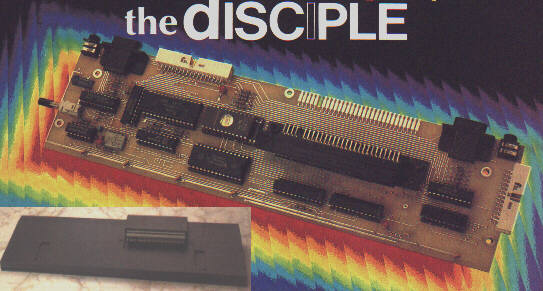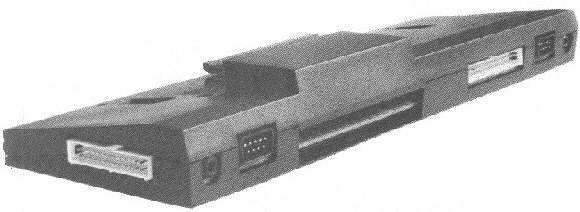The Disciple
One of the problems with the Spectrum is that in order to build up a sophisticated system, you must add on many peripheral units, all of which must plug in to the user port. What's obviously needed is an interface which serves many functions, and if possible offers some new facilities, The Disciple seems to qualify on all counts. This
innocent-seeming unit offers disc drive interfacing, disc
program transfer, centronics printer interfacing,
networking and dual joystick ports, and costs a lot less
than buying all these separately (apart from the obvious The Disciple (awful pun) is similar in appearance to the Sinclair Interface 1, and is in fact compatible with it. It fits onto any Spectrum, via its standard user port connector, and is screwed into place, tilting the Spectrum to a convenient typing angle. To the
right of the unit is the disc drive connector, to the
rear are the networking sockets, twin D-type joystick
ports, follow-on user port and centronics printer port.
On the left are the two control buttons; the inhibitor,
which The virtue of the Disciple is that it can be used with any standard disc drive, single or double density, single or double sided, 40 or 80 track, 3 inch, 3.5 inch, or 5.25 inch. Likewise, any Centronics printer will do. This is because the operating system, which is initially loaded from cassette, can be tailored to whatever add-ons you have. The pre-production version of the operating system consists merely of a series of text screens asking you to enter codes to define the type of drive, type of printer, and various options for line spacing, special printer functions, networking features and so on. Once you have defined your system, you can save the file to a ormatted disc for future use. In operation, the system file resides in the Disciple's Ram and so takes up no Spectrum memory space. Unfortunately you must use the inhibit button to disable certain functions if you want to use a microdrive and Interface 1 while the Disciple is attached. The Disciple disc operating system allows up to 800K to be stored on a double sided double density disc. You can use any disc drive with a standard Shugart connector; typically, a BBC compatible unit. Up to two disc drives can be used connected, using file names of up to ten characters to store several different types of file: Basic, data arrays, character arrays, machine code, screens, microdrive format or ‘snapshots’. The different types of file are identified with a code letter and a display of the file space used, when you list them using the Cat command. The syntax
used for the disc drives can be the same as that for
microdrives, to make life easier; however, there is a
simpler syntax available which addresses the drives using
the prefix Dl (or D2). Files can be renamed, copied,
erased, autoloaded, and so on. The computer can be reset
without disrupting the DOS, and you can also use the
Disciple’s snapshot button to dump the entire 48K
(not 128K) program to a disc. This is of obvious Using a printer is pretty straightforward; having defined your operating system in the question-and-answer session, you just use LPrint and Llist. Two positioning commands, Tab and At, are also provided. It's also possible to produce screen dumps from any program, using the snapshot button and the caps shift key. Networking allows up to 68 Spectrums to be linked with Disciples, to be linked together in a system sharing master disc drives and printers The applications, especially for education, are obvious; again, the file serving system is defined in an opening question-and-answer session. Finally.
the Disciple's two joystick ports can be used either as
Kempston standard (single stick) or Sinclair (double
stick). With a claimed data transfer rate of 125K/second
using a single density drive, and access time of one
second, the Disciple's most obvious virtue is that it
gives Spectrum owners easy access to disc storage. My only reservations about what must be seen as a very desirable purchase are that the pre-production manual and operating system software are pretty primitive - a huge amount of prettifying would be useful - and that both of the review models switches disintegrated. A dab of superglue needed there, Rockfort. That apart, I can't think of many Spectrum owners who would not leap at the chance to get their hands on the Disciple. The following review was taken from Sinclair User - March 1987 Say hello to the Disciple – a holy wonderful interface.
The break up of Sinclair Research has produced a swarm of peripherals from ex-employees with an intimate knowledge of the Spectrum and a mortgage to feed. The latest add-on from the exclusive ex Sinclair club is the subtly named Disciple disc / printer / joystick / network unit. Canonised in September, at the same time as the 128K+2, its already into the second version, and this is the one reviewed here. The Disciple resembles nothing so much as an overgrown Interface 1. It fits in the same way, with a couple of screws bolting it to the underside of Spectrum 48K’s and it’s compatible with both 128K’s and 128K+2’s. The connectors used to hook up to the unreasonably large number of accessories that it supports are mostly BBC micro type, thus assuring lots of leads available immediately. See, the Beeb is good for something. Briefly, you can use any disc drive, any parallel printer, any standard joystick, and network to any other Disciple or Interface 1 that you happen to have lying around. It’s also got the obligatory Magic Button, for putting desirable data on to disc by divine intervention. The first time you use your Disciple, you have to configure it to your specifications. This is done by a short and explicit program loaded from cassette. You get asked various questions about your disc drive, your printer and exactly how you want to use the network. The program is logical, painless and well explained in the manual. Once that’s done, a disc is formatted by the program and your personalised system is saved. That disc is used in future for starting everything up but, if you find that you’ve got something wrong or you buy a new printer, you can always configure it again. It only took me about three minutes, including looking things up in my printer handbook. The network is better than the old Interface 1, as one station can always talk to another, even if the other is busy. Perfect for schools with lots of Spectrums, especially since all stations can use one disc drive, and a station designated Master can look at the screen of any of the pupils on the net. The joystick can be either Kempston or Sinclair type, which covers just about every game ever written. They work, too. As the software inside the disciple doesn’t use any of Spectrum’s Ram, it will work with most commercial games and stuff. I took a peek inside, and was suitably impressed with the quality of construction. Just a couple of wire links. better than the Interface 1. All these facilities are available from Basic in much the same way as interface 1 did it (like Load *"M",1, "Kalisti), or by friendlier syntax (Load D1 "hoopla") or by selecting a program from the catalogue listing (Load P3 loads the third program on the catalogue). The snapshot button works well, too. A bonus over other similar products is that if you press Cap Shift before pressing the snapshot button, you get a copy of the screen on your printer. Very useful to prove to your friends that you really have got to the end of Zappem. And if you have a game or peripheral that objects to the Disciple, there’s an Off button. There’s a full edge connector brought out to the back, In fact it’s even got some extra signals, to do with the disc drive. And it all works luverly. The manual’s good, clear and with a few helpful hints that might even stop people writing to Sinclair Surgery. Techies will like the list of port addresses (but there’s not much more heavy info}, and I hear tell of a hook-code compatible version on the cards. I’m impressed. With peripherals like this, the Spectrum can walk on water. This interface saint bad (that’s enough religious jokes Ed) |
| [ Main Page ] [ Features ] |

